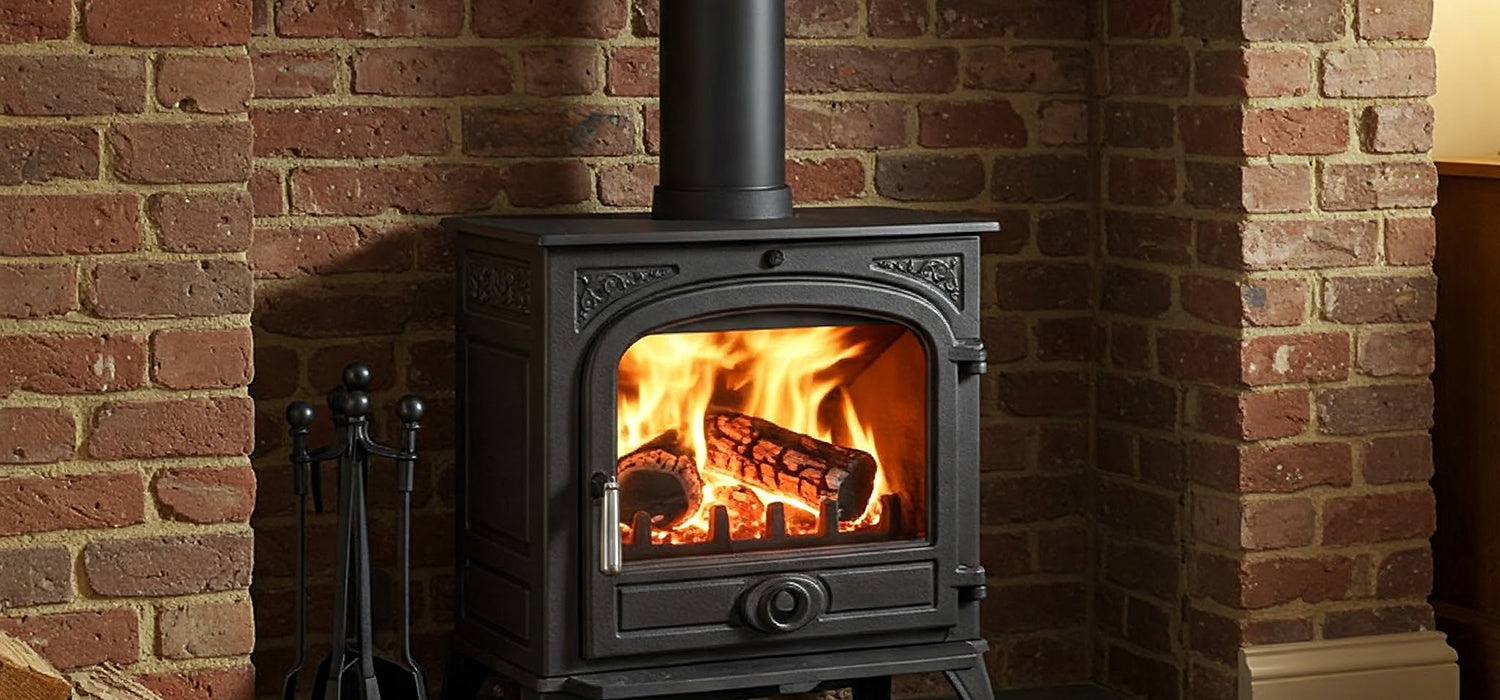
How Long Does a Log Burn in a Stove?
Ever feel like your log burner eats logs for breakfast? Short answer: a log can burn anywhere from 1.5 to 8 hours, depending on wood type, size, and stove setup. Stick around to learn how to make every log last longer — and keep that cosy glow going strong.
The Burning Question: What's the Average Log Burn Time?
Initial Factors Influencing Burn Duration
Size of the Log: Big vs. Small
Small logs catch quickly and offer a fast burst of warmth, but they vanish just as fast. Larger logs take a while to get going, but once they do, they provide a steadier, more sustained burn. It's all about finding the right balance for your stove size and heat needs.
Type of Wood: Hardwood vs. Softwood
Think of hardwoods like oak or ash as the slow-cookers of the firewood world — dense and long-lasting. Softwoods, like pine or spruce, are more like microwave meals — quick, hot, and over in a flash. Both have their place, but if longevity is your goal, hardwood is your friend.
Moisture Content: The Importance of Seasoned Wood
Trying to burn wet wood is like lighting a soggy biscuit. It’s smoky, inefficient, and leaves your stove messy. Well-seasoned or kiln-dried logs — with less than 20% moisture — burn hotter, cleaner, and much longer.
Average Burn Times for Common Wood Types
Oak: The Long-Lasting Choice
Oak is a firewood favourite for good reason. It burns slowly and steadily, often lasting 6–8 hours when seasoned properly. Perfect for overnight heat.
Ash: Good Heat and Decent Burn
Ash lights easily and gives off reliable heat. You can expect a solid 4–6 hours of warmth with well-dried logs.
Birch: Quick to Ignite, Faster Burn
Birch is great for kindling or a quick top-up fire. It lights fast and burns with enthusiasm — but usually only for 2–3 hours.
Other Hardwoods (e.g., Beech, Maple)
Woods like beech and maple fall nicely between oak and birch, typically offering 4–6 hours of consistent, useful heat.
Softwoods (e.g., Pine): Faster Burn, More Frequent Loading
Softwoods are best kept for kindling or shoulder season burns. Expect 1.5–2.5 hours at most — and keep the stove door nearby.
Key Factors That Determine How Long a Log Burns
Wood Properties and Preparation
Density of the Wood
Dense woods burn longer simply because there’s more material to work through. That’s why hardwoods are the go-to for extended heat.
Seasoning and Moisture Levels
Logs need time to dry, ideally for at least 6–12 months. Kiln-dried wood skips the wait and delivers consistent, reliable performance straight away.
Log Shape and Size
Split logs catch and burn more evenly than round ones. They also stack better and help airflow within the firebox.
Stove and Burning Conditions
Stove Efficiency and Design
Modern log burners are designed to hold onto heat and reduce emissions. Older models may be charming but are often less efficient, wasting precious warmth.
Airflow Control and Damper Settings
Once your fire is roaring, dial back the airflow. Less oxygen slows the burn and makes each log go the distance.
Firebox Size and Loading Method
A larger firebox gives you room for longer logs and more consistent heat. But stacking technique matters too — leave enough room for air to circulate.
Instrformance.
Effective Fire Building Techniques
The Importance of a Good Coal Bed
A glowing coal bed acts as a steady foundation. Let your first logs burn down before refuelling for smoother ignition and longer-lasting heat.
Packing Logs for Slow Burning
Stack logs close enough to support each other, but not so tightly they stifle airflow. It’s all about balance.
Top-Down vs. Bottom-Up Fire Building
Top-down fires (kindling on top, logs at the base) produce less smoke and burn cleaner. They also give you that handy coal bed more quickly.
Optimising Stove Settings
Controlling Airflow for a Slower Burn
Once the fire is well lit, reduce the air supply. It slows combustion, making each log burn longer — and saves you a few trips to the log pile.
Using a Stove Thermometer for Efficiency
Stay in the sweet spot (around 120–250°C). Too low, and you’ll get smoke and creosote; too high, and you’ll blaze through your logs.
Log Management and Preparation
Splitting Logs for Optimal Size
Logs that are too big won’t catch well. Too small, and they’ll disappear in minutes. Aim for a good middle ground based on your stove size.
Proper Log Storage
Store logs off the ground in a dry, ventilated area. Covered log stores work brilliantly — rain-soaked wood just won’t perform.
Burning Wood Safely and Efficiently
Avoiding Problematic Woods
Resinous Woods and Creosote Buildup
Pine and similar softwoods can leave sticky deposits in your flue. Burn sparingly and keep your chimney swept.
Unseasoned Wood Issues
Burning wet logs leads to excess smoke, poor heat output, and messy stoves. Stick to dry fuel for happier fires.
The Importance of Chimney Sweeping
Have your chimney swept at least once a year. If you burn daily through winter, consider twice. It’s essential for safety and performance.
Understanding Stove Safety Guidelines
Always follow your manufacturer’s instructions. Don’t overfill, don’t burn waste, and never leave a stove burning unattended.
Conclusion: Enjoying Long-Lasting Warmth from Your Wood Stove
Getting the most out of your log burner comes down to smart wood choices, airflow control, and good habits. Use the right fuel, stack it properly, and keep everything well maintained. With a little planning, you’ll enjoy longer burns, warmer nights, and fewer dashes out into the cold for more logs.allation and Maintenance
Proper Venting and Installation
A well-vented stove burns cleanly and efficiently. Poor draught or a blocked flue will smother your fire and shorten your burn.
Regular Stove Maintenance
Keep your stove and flue clean to allow proper airflow. A clean stove isn’t just safer — it burns longer and more efficiently.
Maximising Burn Time: Tips for a Longer-Lasting Fire
Choosing the Right Firewood
Prioritising Dense Hardwoods
For long, steady heat, stock up on oak, ash, beech, or hornbeam. These woods go the distance and make for less frequent refuelling.
Ensuring Kiln-Dried or Well-Seasoned Logs
Don’t waste your time (or kindling) trying to burn damp logs. Kiln-dried wood is ready to go, while seasoned logs — dried naturally for at least 6–12 months — offer reliable, clean-burning heat. Use a moisture meter if you're unsure, and aim for logs under 20% moisture content.
Other content we think you'll love
- Can Log Burner Glass Break?
- How Do Log Burner Fans Work?
- The Truth Behind the Smell of a New Log Burner
- The Ultimate Guide to Choosing the Best Wood for Your Log Burner
- What Flue for Log Burner: Choosing the Right One for Your Home
- The Ultimate Guide to Choosing the Right Cowl for Your Log Burner
- What Is a Log Burner Service?
- Who Can Sign Off a Log Burner?

